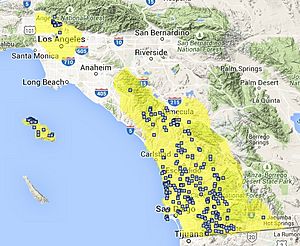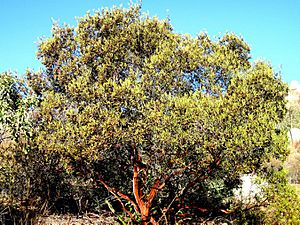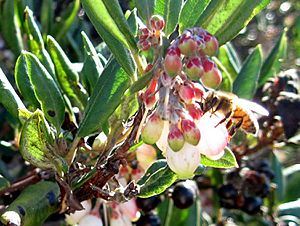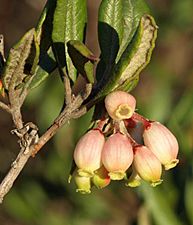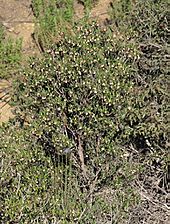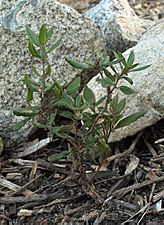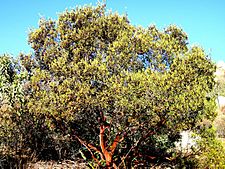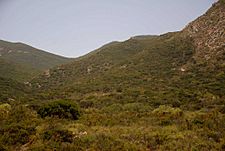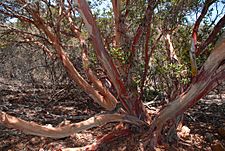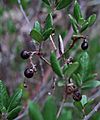Mission manzanita facts for kids
Quick facts for kids Mission manzanita |
|
|---|---|
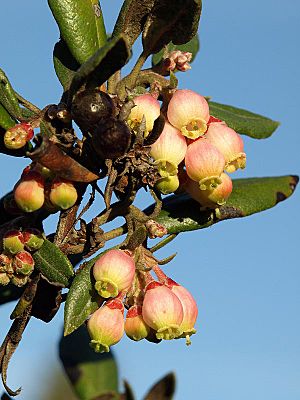 |
|
| Xylococcus bicolor in bloom with old fruit and leaves | |
| Scientific classification | |
| Genus: |
Xylococcus (plant)
|
| Species: |
bicolor
|
Xylococcus is a monotypic genus of flowering plants in the heath family which contains the single species Xylococcus bicolor, the mission manzanita.
The genus Arctostaphylos (manzanitas) and Xylococcus are both in the family Ericaceae. It was formerly classified as Arctostaphylos bicolor. The name Xylococcus comes from the Greek for "wood berry".
Distribution
The plant's native range is very limited, to the Peninsular Ranges in Southern California (U.S.) and northern Baja California state (México), the South Coast of California and the northwestern Baja California coast, and on Santa Catalina Island. Its populations are primarily in San Diego County, California and Baja California state.
It is a member of the chaparral plant community, in the California chaparral and woodlands and California coastal sage and chaparral ecoregions. It grows at elevations below 3,500 feet (1,100 m), on dry, sunny slopes.
Description
Xylococcus bicolor is a slow-growing shrub that resembles the true manzanitas (Arctostaphylos). The form is upright, usually with multiple trunks and a roughly spheroid crown. It grows up to 5 metres (16 ft) in height and 3 metres (9.8 ft) in diameter.
Leaves are oblong, glossy dark green on the top and very light colored with a felty texture on the underside. The edges of the leaves curl under as they age. Bark is smooth and a red-gray color.
Flowers, which appear from December to February depending on rainfall, are white to pink in color blending to yellowish at the open end, 8–10 mm in length and hang like bells in small clusters near the ends of branches.
Fruit is glossy dark red to almost black, 7 mm diameter and has very little flesh, being mostly a large, woody seed.
- Mission manzanita
Ecology
Birds, including the California thrasher and scrub jay, eat its seeds. Hummingbirds, especially the resident Anna's hummingbird, drink nectar from its flowers. Various birds nest in the plant, and many use it for cover.
While some chaparral plant species require fire to germinate seeds and reproduce, Xylococcus bicolor does not, nor does it require openings left by wildfires. But as a chaparral member species it must have a means of coping with wildfire. It does so by resprouting from the base after its top has burned away. This mechanism works very well unless a second fire follows closely after the first. If the plant has not had time to sufficiently regenerate it will probably perish.
Uses
The Native American Luiseño people bruised ripe berries and soaked them overnight in cold water to produce a cider-like drink.
Cultivation
Xylococcus bicolor is cultivated as an ornamental plant by specialty plant nurseries, for planting in California native plant and wildlife gardens. It prefers to have its leaves in full sun, but likes its roots in the shade. It needs fast draining soil of pH 6–7, in USDA zones 7–10.
It is best to plant mission manzanita in late autumn on dry rocky slopes. A thick layer of mulch and several good sized rocks over the roots slows summer moisture loss. In gardens it prefers regular light watering (1x every 2 weeks) over the first summer after planting, After established, it should survive the dry months with no supplemental water, though it can usually handle summer watering up to once per month for its first 2–3 years. The plant prefers to have its leaves in full sun, but likes its roots in the shade, and does best on north facing slopes.
Coyote scat is a good source of fertile seed. At certain times of the year their scat is full of the seeds. Apparently the acid wash helps germination.
Gallery
- Ecology
Images for kids
See also
 In Spanish: Xylococcus bicolor para niños
In Spanish: Xylococcus bicolor para niños


